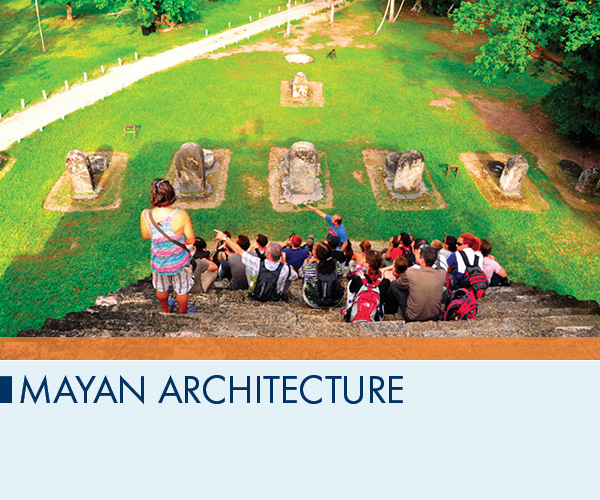
Previous Chapter | Next Chapter | Table of Contents
One look at the monumental architecture of the Maya, and you might feel transported to another world (perhaps that’s why Tikal was used as the rebel base in the original 1977 Star Wars). The breathtaking structures are even more impressive when you consider that they were built 1,000 to 2,000 years ago or more, without iron tools, wheels, or pulleys. The following is a brief explanation of the architecture you see at a Mayan ruin.
Influences
Mayan architecture, even the great temples, may echo the design of the typical thatch hut ordinary Maya used for thousands of years. The rectangular huts had short walls made of a limestone mud and were topped by a steeply tilted two-sided thatch roof. Caves—ever-important Mayan ceremonial sites—were also influential. Many aboveground Mayan temples and other monumental structures have cave-like chambers, and the layout of Mayan cities probably reflected the Mayan cosmology, in which caves played a critical role.
Building Materials
With few exceptions, the large buildings in Mayan cities were constructed mostly from limestone, which was widely available in Belize and the Mexican Yucatán. Quarries were often established close to a building site so that workers didn’t have to haul stone long distances. The Maya used limestone for mortar, stucco, and plaster. Limestone was crushed and burned in wood-fired kilns to make lime. A cement-like mortar was made by combining one part lime with one part of a white soil called sahcab, and then adding water.
The Maya also used wood, which was plentiful in Mesoamerica. In fact, some of the early temples were probably constructed of wood poles and thatch, much like the small houses of the Maya; unfortunately, these buildings are now lost.
Tools
The Maya were behind the curve with their tool technology. They didn’t have iron tools, pulleys to move heavy weights, or wheels to build carts. They didn’t have horses or other large animals to help them move materials. Instead, they used large numbers of laborers to tote and haul stones, mortar, and other building materials.
Obsidian, jade, flint, and other hard rocks were used to make axes, knives, and saws. The Maya had mason’s kits to cut and finish limestone, and they had the equivalent of a plumb bob and other tools to align and level stones. The Maya were skilled stoneworkers, although the degree of finish varied from city to city.
City Layout
In most Mayan cities large plazas were surrounded by temples and large pyramids, probably used for religious ceremonies and other important public events. Paved causeways connected the plazas. Away from the city center were sprawls of “suburbs”—smaller stone buildings and traditional thatch huts.
Most cities had ball courts, and although the exact rules are unclear, players used a ball of natural rubber (rubber was discovered by the Olmecs) and scored points by getting the ball through a hoop or goalpost. “Sudden death” had a special meaning—the leader of the losing team was sometimes killed by decapitation.
The celebration of Belize’s historic multiculturalism begins on its flag: the two young men—one black and the other white—are woodcutters standing beneath a logwood tree. Under them is a Latin inscription: sub umbra floreat—“In the shade of this tree we flourish.”
Previous Chapter | Beginning of Chapter | Next Chapter | Table of Contents